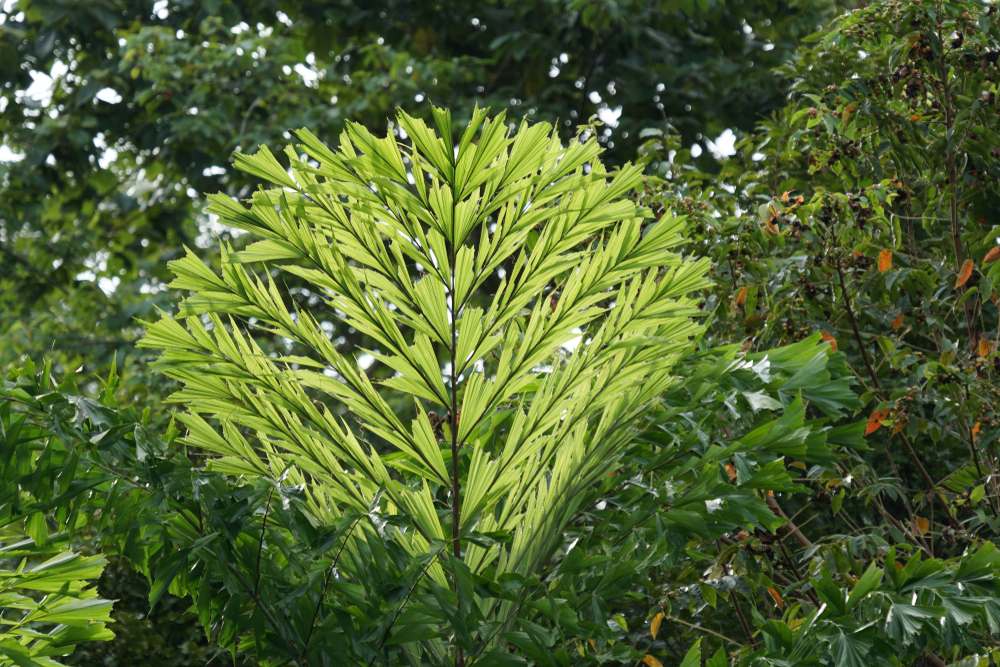The Fishtail Palm (Caryota genus), a botanical wonder known for its unique fishtail-like leaves, is tucked away in the middle of tropical landscapes. In this article, we will explore the history, special traits, methods of cultivation of Fishtail Palm, and the various ways it improves natural and cultivated settings.
See also: How to grow and care for honeysuckle?
Key facts: Fishtail palm
| Botanical name | Caryota spp. (varies by species) |
| Common names | Fishtail Palm, Jaggery Palm and Toddy Palm |
| Family | Arecaceae |
| Native area | Southeast Asia, South Asia and the South Pacific |
| Plant type | Tropical palm tree, typically clumping with multiple stems |
| Mature size | Varies by species and environmental conditions, can reach up to 66 foot in height |
| Sun exposure | Full sun to partial shade |
| Soil type | Well-drained soil tolerates a range of soil types |
| Flower size | Small, inconspicuous flowers on branching inflorescences |
| Flower colour | Creamy to yellowish |
| Toxicity | Generally non-toxic to humans; however, caution is advised as some reports suggest potential pet toxicity. |
Origins and taxonomy: Fishtail palm
The Fishtail Palm is a genus of palm trees that belongs to the Arecaceae family. It contains approximately 13 species. These palms, native to Southeast Asia and the South Pacific, do well in warm, tropical climates. Among the different species, Caryota gigas and urns are especially well-known for their striking appearance and ornamental appeal.
Distinctive features: Fishtail leaves and growth structure
The Fishtail Palm gets its name from the peculiar way its leaves look, like a fish’s tail. In contrast to many palm varieties with traditional feather-like fronds, the Fishtail Palm has deeply lobed bipinnate leaves resembling a fish’s serrated fins. This unique foliage gives any landscape a sense of tropical elegance.
The Fishtail Palm grows in clusters or clumps, forming several trunks from the base to form a dense, lush canopy. It is popular for ornamental planting in gardens, parks and botanical landscapes because of its towering trunks and striking foliage.
Cultivation secrets: How to nurture a flourishing fishtail palm?
- Climate: Warm temperatures and high humidity are ideal for Fishtail Palms, which grow best in tropical and subtropical regions. The best growing conditions are found in well-draining soil with additional organic matter, though they can tolerate a range of soil types. Where there is little chance of frost, these palms grow well outdoors.
- Sun exposure: Fishtail Palms, true to their tropical origins, prefer lots of sunshine. Plant them for robust growth and vibrant foliage where they receive partial to full sunlight. They are adaptable to shady environments and to be added to various outdoor settings.
- Watering schedule: The health of the Fishtail Palm depends on having enough moisture. Frequent irrigation helps keep the soil moist, especially in arid periods. However, because Fishtail Palms are prone to root rot, avoiding wet conditions is imperative. Mulching the area around the base helps keep the soil moist.
- Fertilisation techniques: The nutritional requirements of the Fishtail Palm are supported by applying a balanced fertilizer during the growing season, usually spring and summer. Choose a fertiliser with a slow release if you want to maintain growth for a long time. Frequent feeding promotes overall plant health and lush greenery.
Fishtail palms in landscaping: Aesthetic appeal and practical uses
Fishtail palms are highly valued for their ornamental value and are often used as focal points in tropical and exotic landscape designs. Their unique look gives a dramatic touch and makes a visually arresting contrast with more conventional plantings.
Screening and privacy: Fishtail Palms are great natural screens because of their lush foliage and clustering growth habit. An attractive and practical way to achieve privacy is by planting them strategically along property lines.
Container gardening: Fishtail palms do well in containers, even though they grow well in the ground. With the right maintenance, gardeners in a variety of climates can appreciate the charm of these palms on patios, balconies or even indoors.
Challenges and mitigation: Common issues in fishtail palm care
Pest infestations: Scale insects and mites are among the pests that fishtail palms may attract. These annoyances can be avoided by routinely checking the leaves for indications of infestation and applying neem oil or insecticidal soap.
Diseases: Fishtail palms are generally hardy but can get fungal infections, especially when damp. Diseases like leaf spots can be avoided by maintaining adequate spacing, ensuring good ventilation and avoiding overhead watering.
Environmental significance: Fishtail palms in biodiversity and conservation
Fishtail palms contribute to biodiversity in addition to their aesthetic value. For many bird species, the dense canopy serves as a home and a place to nest, which maintains the ecological balance. Maintaining the varied ecosystems that Fishtail Palms are a part of depends on conservation efforts to protect their natural habitats.
Cultural significance and traditional uses of fishtail palms
Fishtail palms are important to the local culture in areas where they are native. Traditional practices make use of the leaves and sap of the palm, among other parts of the plant. For many years, the local communities have relied heavily on these palms for everything from thatching roofs to producing baskets and extracting palm sugar.
Culinary uses and economic importance
Certain Fishtail Palm species serve more than just decorative and cultural purposes; they also have commercial value in the food industry. A common sweetener in Southeast Asian cuisine, palm sugar is made from the sap of some varieties. To extract sap using the traditional method, one must tap into the inflorescence and gather the sap in containers.
Fishtail palm: Toxicity
Most people believe that Fishtail Palms (Caryota spp.) are safe for human consumption. But, it’s best to exercise caution—especially if you own pets—as some reports indicate that animals could become poisoned if they consume it. Although the fruits are edible for humans, pets may experience mild gastrointestinal discomfort if they consume plant parts. Like any other plant, Fishtail Palms should be kept out of the reach of animals. If an animal were to accidentally ingest one, it would be best to seek emergency medical attention to protect the pet’s health.
FAQs
Can fishtail palms survive in non-tropical climates?
While Fishtail Palms thrive in tropical and subtropical climates, some varieties can adapt to slightly cooler conditions. However, they are generally more suited to warmer environments, and in colder regions, protective measures such as frost cloth or moving them indoors during winter may be necessary.
Do fishtail palms require regular pruning?
Fishtail Palms benefit from occasional pruning to remove dead or damaged fronds and maintain a tidy appearance. However, excessive pruning is not recommended, as it can stress the plant. Prune sparingly and focus on removing only the necessary fronds to promote healthy growth.
Are fishtail palms suitable for indoor cultivation?
Some smaller varieties of Fishtail Palms can adapt to indoor environments, provided they receive sufficient sunlight and proper care. Indoor cultivation requires attention to factors such as humidity levels, watering and occasional fertilisation. Ensure the chosen variety is suitable for container gardening.
What are common signs of pest infestations in fishtail palms?
Common pests that may affect Fishtail Palms include mites and scale insects. Signs of infestation include discoloured or distorted leaves, webbing on the foliage, and the presence of tiny pests. Regularly inspect the leaves, especially the undersides, and treat any infestations promptly with insecticidal soap or neem oil.
Can fishtail palms be grown from seeds, and how long do they take to mature?
Fishtail Palms can be grown from seeds, but they require patience. Germination can take several weeks and the palms typically take several years to reach maturity and develop their distinctive fishtail leaves. For faster results, many gardeners prefer to purchase established young palms from reputable nurseries.
| Got any questions or point of view on our article? We would love to hear from you. Write to our Editor-in-Chief Jhumur Ghosh at jhumur.ghosh1@housing.com |






